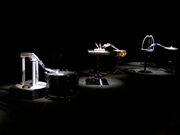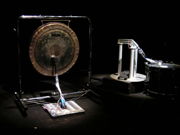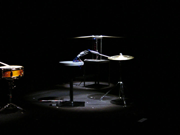|
1. Explanation of robots

The 5 robots play the musical instruments. These consist
of Snare Drum, Bass Drum, Cymbal, Gong, and Pipe. These are
created with the conception and the design by Suguru Goto
and with a technical help by Fuminori Yamazaki, iXs Research
Corp. in 2003. These works were already exposed in exposition
and performed in a concert during a festival at Xebec Hall
in Kobe, Japan, in March 2003.

These robots perform the percussion instruments, instead of
human players. These robots are connected with a computer
and controlled by the program in a computer. These can play
very complex music which can not be done by a human performer.
These can play much faster or can play forever without any
rest. This may allow to create music which never be able to
listen in the past. These can also controlled by a gesture
of human with an application of Virtual Reality System with
Data Suite or a motion capture system. Movements of human
are analyzed with a computer, then this is transmitted to
the robots. In other words, a gesture that a human pretends
to play an instrument in air, can trigger the robots, which
really play the instruments instead of human.
2. Works
a. Concert

Using the above-mentioned robot, the artists show their works
in public. How can one coexist with a robot, and what could
the relationship with human be? What are the differences between
a human player and a performance of a robot? Can one of them
exceed another or what is the point of disadvantage in another?
We may explore how much the present technology of robot may
respond to these, while we explore the difference between
human gestures and robot acts for music in which the advanced
intelligence is necessary.
A robot can perform correctly and faster than man. Moreover,
man is not possible to repeat the same pattern permanently,
but a robot can do so. However, a human player may be able
to perform with delicate expression of music. When a robot
actually performs simultaneously with a human player, we can
perhaps observe its own special kind music expression, such
as mechanical aspects.
b. Exhibition
We actually made their works using the above-mentioned robots
in this exhibition, and carry out the demonstration of the
robot's possibility. Five robots are always exhibited. The
mode in which a pattern and music were prepared beforehand,
and a public can also choose the mode of performance. The
former one is a mode in which some patterns and some compositions
are written in Max/MSP. The latter one is a mode that a public
actually can perform the robots by clicking the screen of
a computer with a mouse and so on in real time. The algorithms
of Max patches are prepared by the composers.
   
3. About the Robots
For this project, we have developed our own robots with our
original design. These has been made by a robot company, iXs
research Corp. These are based upon the idea that the robot
plays the acoustic musical instruments. Each robot resembles
a part of man's body, such as an arm and a leg etc. and imitates
the gesture of human's performance. These robots are controlled
by a computer with a program, Max/MSP/Jitter in real time.
Unlike a robot which walks himself by his two feet, or a robot
which judges and pursues an object himself, the artificial
intelligence of these robots are minimized and these are considered
that these can be freely changed by programming with Max/MSP/Jitter
and these can be flexibly changed to have various functions
in order to be more advanced intelligence. These emphasize
a viewpoint of gesture for musical performance, in another
words, an act, rather than these depend on the portion of
intelligence for maintaining balance itself, or judging an
obstacle. Man's performance act apparently looks like a simple
motion, but is indeed complicated in fact. A usual professional
player has received severe training since his childhood, and
in order to perform a composition he has to have many practice
and ability sufficient. The points are the musical expression
capability for performing music, as well as how much the muscles
of the body are delicately controllable for the reason. Can
we reproduce the complicated performance act that is based
on the long training of the player, and can we also exceed
the human player with a robot? In order to create good sound
by the musical instrument, what sort of delicate motion, and
how are these required to put in speed and power? What are
the exact mechanism of a motion of man's muscles and the work
of a brain to it? How could it be possible to reproduce, such
as good performance and good music? When we research these
then realize in an experiment, we can perhaps discover the
mystical mechanism how man has developed the brain for a long
time. That is to say, these are not at the stage of mechanism,
such as walking, holding etc. which is for a portion of primitive
brain, however these are the portion of advanced brain for
sensitivity, emotion and the very delicate body control. It
is a new filed of research, which are hardly solved in the
past.

|

